
Funk Family Game Night
Game night with the Funks!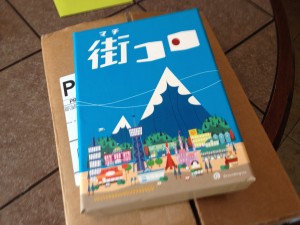 It is pretty rare in our household when a game is thoroughly enjoyed by the majority of the family (that means 3 of 4, not 5, since Maddie isn’t really old enough to play). It’s even more rare when Jenn is one of that majority. And even rarer STILL when she specifically suggests playing games in the evening just to play a particular game.
It is pretty rare in our household when a game is thoroughly enjoyed by the majority of the family (that means 3 of 4, not 5, since Maddie isn’t really old enough to play). It’s even more rare when Jenn is one of that majority. And even rarer STILL when she specifically suggests playing games in the evening just to play a particular game.
Machi Koro, by IDW Games, is one such rarity. Machi Koro is a Japanese dice-rolling, card-building game set to be released in the US in August of 2014. Starting with just a wheat field and a bakery, you are tasked, as the mayor, with building your city into one of which all of your residents will be proud. Do you focus on a few specific industries? Do you diversify and hope that the sheer variety in your town is enough? Many strategies may appear promising, but only one mayor will be the first to build their 4 landmarks and become the savior of their town and the envy of their peers.
 Since Machi Koro isn’t due to be released until later this year, I had little hope of ever getting a chance to play it beforehand. However, IDW Games was gracious enough to have a giveaway to celebrate their 500th Twitter follower. I used to claim that I never won ANY contests, but apparently I’ll have to start revising that statement. Twitter contests have been very good to me over the last year and a half, and the latest gift of that lucky streak was an early pre-production copy of Machi Koro! I’d love to think my luck will continue to hold out, so check this space for reviews of new winnings in the future! 🙂
Since Machi Koro isn’t due to be released until later this year, I had little hope of ever getting a chance to play it beforehand. However, IDW Games was gracious enough to have a giveaway to celebrate their 500th Twitter follower. I used to claim that I never won ANY contests, but apparently I’ll have to start revising that statement. Twitter contests have been very good to me over the last year and a half, and the latest gift of that lucky streak was an early pre-production copy of Machi Koro! I’d love to think my luck will continue to hold out, so check this space for reviews of new winnings in the future! 🙂
Because this is a pre-release copy, I can’t really speak to the overall quality of the components in the final version, but I can at least describe what I received. The box appeared to be a standard box with a wrap. The graphics on the box are completely in Japanese, unlike the pictures I’ve seen of the English version to be released. The cards themselves are fine (and in English), though they’re already showing wear (some wear apparent from the plays they received prior to arrival). They were held simply by a couple of rubber bands. The ‘coins’ I received were simple colored chips (white for 1s, red for 5s, yellow for 10s) in a plastic baggy. The instructions were printed nicely on a glossy bi-fold sheet of paper and, again, were in English. No dice were in the box, but that had little bearing since I could just reach into my dice-bag-of-holding and grab a pair.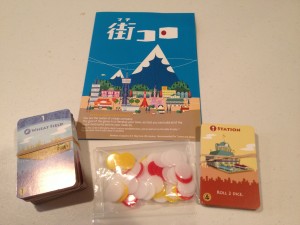
Though the quality isn’t what you’d expect from a production release, the graphics and design of the components still make quite a statement. The box, Japanese and all, really stands out with its simple and elegant style. I was really glad that the production box, from the images I’ve seen, pays homage to the look and feel of the Japanese version while adding English branding. The cards are cute and ‘whimsical’ and nicely portray and differentiate the variety of buildings and landmarks.
The instructions are obviously a pre-release version. They’re clear and concise and easily understood, but the example graphics show the Japanese version of the cards. The examples provided are helpful to get you started. Once through a couple of games, though, there’s no reason to refer to them anymore and the instructions as a whole have mostly remained in the bottom of the box.
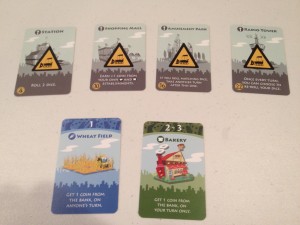 I knew Machi Koro would be at least a mild hit with our family the moment I started explaining the rules, because mere moments later, I was done. Simple and easy-to-understand rules are highly favored, especially by Jenn. Setup of the game, too, is extremely simple, as long as you take care when putting the game away. If you return the cards to their stacks prior to combining them, setup takes a couple of minutes. If you toss all your cards into a big pile at the end of your game, be prepared to spend several minutes sorting and collating prior to beginning your next. Since we always take the extra time at the end, setup is always quick and easy.
I knew Machi Koro would be at least a mild hit with our family the moment I started explaining the rules, because mere moments later, I was done. Simple and easy-to-understand rules are highly favored, especially by Jenn. Setup of the game, too, is extremely simple, as long as you take care when putting the game away. If you return the cards to their stacks prior to combining them, setup takes a couple of minutes. If you toss all your cards into a big pile at the end of your game, be prepared to spend several minutes sorting and collating prior to beginning your next. Since we always take the extra time at the end, setup is always quick and easy.
The other benefit of the easy rules in Machi Koro is that you can jump right into your first game and, basically, learn as you go. The majority of what you need to remember is printed on the cards. Once you’ve played for a bit, the most basic cards are memorized and only the more advanced cards need to be consulted on occasion when their totals are up. This happened with our first game as a family and the first game my mom played when she visited. That kind of quick start up and play is a huge factor in whether a game hits our table with new players.
A turn consists of 2 easy steps:
- Roll die (1 at the start of the game, or your choice of 1 or 2 after you’ve built the station landmark) and resolve
- Purchase 1 building or build 1 landmark
So simple! The total of the die (or dice) may match cards in play. If, allowing for the rules on whose turn it is, one of your buildings matches the total, you gain income! The cards are color-coded per their rules, as well:
- Blue cards, when matched, provide income on ANYONE’S turn
- Green cards, when matched, only provide income on YOUR turn
- Red cards, when matched, only provide income on someone ELSE’S turn, and the income comes from that player
- Purple cards, when matched, only provide income on YOUR turn, and that income comes from other players
The specifics of each transaction, whether it’s a set number of coins received or a number of coins based on the types of industries/buildings you’ve purchased, are printed on each card. The beauty of this simple game mechanic is that it keeps everyone actively involved in the game at all times. It may not be your turn, but you may get a windfall of unexpected income from a match to one of your blue cards, or you may be devastated by an unlucky purple card, upending your plans. Your current strategy may constantly change at the whim of the dice on your OPPONENTS’ turns.
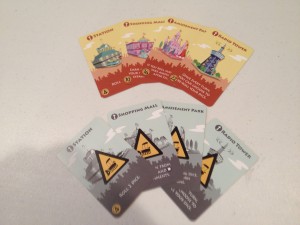 The second half of a turn is the strategic portion. In step 2, you may either purchase an available building from the shared building supply, or you can build one of the four landmarks. In addition to taking you ever closer to victory, the landmarks provide permanent boosts including re-rolls and extra income. If you’d like, you can also choose to save your coins and skip this step, which in certain cases is definitely the right move.
The second half of a turn is the strategic portion. In step 2, you may either purchase an available building from the shared building supply, or you can build one of the four landmarks. In addition to taking you ever closer to victory, the landmarks provide permanent boosts including re-rolls and extra income. If you’d like, you can also choose to save your coins and skip this step, which in certain cases is definitely the right move.
I’ve heard that one of the main criticisms of the game is that it’s a “solved puzzle”, meaning there’s ALWAYS a best choice to make. However, with the amount of luck in the roll of the dice and the various strategies employed by my family, I’ve yet to see one strategy emerge victorious all of the time. I’ve had just as much success buying 9s (which grant 5 coins each on anyone’s roll) as I’ve had employing combinations (purchasing cheap buildings in a single industry and then a card that pays out based on that industry). I’ve had my daughter win on a ‘get a few of everything’ approach while my wife wins with a ‘hope I roll what I need’ tactic. Yes, there’s a measure of playing the odds, but with the balance of a lucky dice roll, a variety of strategies may prevail. One common trait that I’ve noticed from the majority of victories, though, is that if you wait to build the most expensive landmark(s) until last, you’re less likely to succeed. Saving up early and gaining that re-roll landmark seems to be the best option.
One other item I’ve noticed regarding strategy, is that it changes depending upon the number of players. This, in my opinion, is a great selling point! I’ve played several games with both 2 and 4 players. With 2 players, individual turns are much less important than with more players. It’s much easier to drain your resources buying buildings because there’s only 1 roll until your next turn comes up. This lends itself to a lot of skipped purchase phases as you save up for buildings you really want. It can also turn the tide quickly because if a couple of rolls go against you, your opponent has more opportunity to buy and build. With more players, the individual turns become much more significant. If you skip your turn, you MAY really add up the coins, but it may cost you your strategy if the other players buy up the buildings you want (or stockpile buildings according to their own strategy). The risk/reward scenario changes on an single turn with the varying number of players has been intriguing to me.
I think the most interesting statement made to me about the game play was made by my mom: “It’s like monopoly.” At face value, this seems to be a terrible blow. HOWEVER, I believe she’s right. I often hear how people that love Trivial Pursuit should be introduced to Wits & Wagers. Those that like Risk should give SmallWorld a chance. Clue? Try The Resistance. Machi Koro gives choice and decision-making to the roll-and-purchase mechanic of Monopoly, and it does it in a quicker, more elegant, and more FUN package. Instead of rolling the dice, moving to a single location, and choosing to buy or auction (or being required to pay rent), you just roll the dice and resolve all available cards. Rather than being forced to a single yes/no decision, you can now build your monopoly however you’d like. Your CHOICES more dramatically affect the outcome of the game. And, of course, instead of the grind of bankrupting your opponents, you have the much quicker race towards building your landmarks. All in all, I can see how the ‘feel’ of the game is similar, while the execution is much different. Again, I can’t stress enough how much more FUN Machi Koro is, regardless of feel…
I do have 3 complaints about Machi Koro. The first complaint is definitely MY issue, not an issue with the game. During play, I get so caught up with my personal strategy that I often forget the end goal. I WANT that full combination to optimize the coins I’ll get on particular rolls – no matter that Jenn already has her Radio Tower. I want all of the 9s, regardless of how many landmarks Abby has built. Often, once I’ve realized where my single-mindedness has taken me, it can be too late to recover. As I said, deifinitely my issue, but it does lead to my much more significant issue…
I really wish there was some sort of catch-up mechanic! While the fact that this game has very little in the way of ‘take-that’ play – and I find this very appealing – there has come a point in several of our games where we can see who’s going to win and are unable to do anything about it. The game has no hidden data. There is no way to directly force someone to lose coins. Yes, you may have that purple card and steal 5 coins on a lucky roll, and sure you might have stockpiled red cards that could bankrupt them if they’d just roll that 9 or 10, but often the winner has enough coins to win and is just waiting for their turn to come up again. On the flip side, though, we’ve had just as many games decided on the last turn, with players exasperated because their upcoming turn would’ve made them the winner instead. It’s definitely a small gripe, but some way to directly influence in certain situations might be nice. Even a way to surprise the victor at the end somehow could be significant. That may happen in expansions…
Speaking of expansions! I can see a time, down the road, where my family knows each others’ strategies well enough that the game could become stale. Of course, that would hopefully indicate we’d need to ADJUST our strategies accordingly. But, in the meantime, we’d have a familiarity with all of the cards and that may mean less time on our table. I believe this complaint is short-lived, though, as I’ve already heard and read about expansions in the works. I think a game like this will thrive on smaller expansions that allow changes in which cards are available and the types of strategies that can be employed. And I look forward to what will be offered.
I think the highest praise I can give this game is that, even though I own this pre-release copy, I fully plan on purchasing the production version soon after it’s available. Once the expansions are available, I’ll own those, as well. I don’t expect any significant gameplay changes, but the quality upgrade, which in turn will increase the longevity of the cards and such, will be necessary as often as I foresee us playing this.
For Jenn, who has played many games with me – mostly as a family – over the last couple of years, this has been a gateway game of sorts. While the girls were visiting their grandparents for a week, Machi Koro hit our table several nights. The interesting thing, though, is that even when it didn’t, Jenn still wanted to play games. It introduced her to a fun way to unwind from our long days at work when we had nobody to take care of. Rather than vegging out in front of the TV, we played boardgames. I think it’s definitely the start of more of these types of evenings in the future.
My opinion is that IDW Games has a hit on their hands. It has definitely made a positive impact in the game playing habits of my family, and I look forward to many more nights of city planning ahead!
Have you played it, yet? What are your thoughts? Am I completely off base on some of my analysis? Did I totally blunder on my understanding of rules or strategy? Let me know!
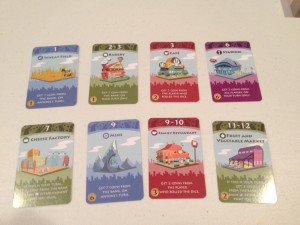


Let me know your thoughts!